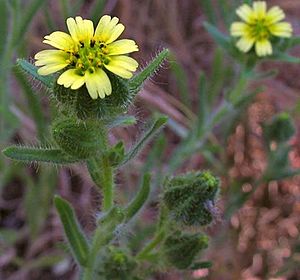Grassy tarweed facts for kids
Quick facts for kids Grassy tarweed |
|
|---|---|
 |
|
| Scientific classification | |
| Kingdom: | |
| (unranked): | |
| (unranked): | |
| (unranked): | |
| Order: | |
| Family: | |
| Genus: |
Madia
|
| Species: |
M. gracilis
|
| Binomial name | |
| Madia gracilis (Sm.) D.D.Keck
|
|
Madia gracilis is a type of flowering plant. It belongs to the aster family. People often call it grassy tarweed, slender tarweed, or gumweed madia. This plant is known for its sticky, resin-covered parts.
Contents
Where Grassy Tarweed Grows
This plant is an annual herb. This means it lives for only one growing season. It grows naturally in western North America. You can find it from British Columbia in Canada, all the way down through California, to Baja California in Mexico. It also grows east into Utah and Montana.
Grassy tarweed can grow in many different places. It likes oak woodlands and mixed evergreen forests. However, it does not grow in very dry desert areas.
What Grassy Tarweed Looks Like
Madia gracilis can look a bit different depending on where it grows. Generally, it is a plant that smells nice. It grows up to about 3 feet (1 meter) tall. Its stem has many branches. The stem feels hairy and sticky because of special glands.
The leaves can be up to 4 inches (10 centimeters) long. They are covered in soft hairs. They also have sticky glands that produce resin.
Flowers of Grassy Tarweed
The plant's flowers grow in clusters. These clusters are called an inflorescence. Each flower cluster has many small "flower heads." These heads are surrounded by special leaves called phyllaries. These phyllaries are very sticky. They are covered in many knobby, stalked resin glands.
Each flower head has two types of tiny flowers. There are yellow ray florets that look like petals. They are only a few millimeters long. There are also several disc florets in the center. These have black anthers.
Seeds of Grassy Tarweed
The fruit of the plant is a flat, smooth achene. An achene is a type of dry fruit that contains one seed. This plant's achenes do not have a pappus. A pappus is usually a feathery or bristly part that helps seeds fly in the wind.
How People Used Grassy Tarweed
Long ago, the seeds of Madia gracilis were very useful. Indigenous people in California used them. The Mendocino, Miwok, and Pomo peoples would collect the seeds. They used the seeds to make a special food called pinole. Pinole is a type of flour, often made from toasted grains or seeds.

